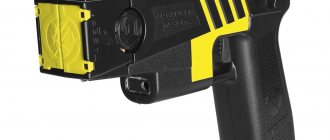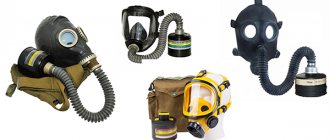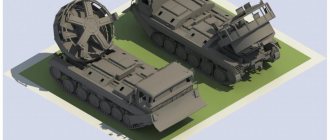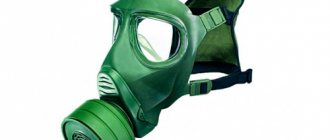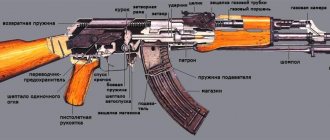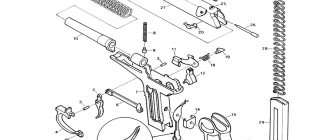Gas masks are necessary to protect the eye area, respiratory organs and facial skin from the toxic effects of nerve gases and other toxic substances. Such compounds can be released into the air during man-made disasters and accidents or military operations.
The history of the development of personal protective equipment goes back several centuries. Now there are new, improved gas masks used in various fields. Their classification includes many different modifications and types, which can be difficult for the average person to understand.
In this article we will look at the most common types and models, understand their purpose, consider their distinctive features and provide information on how to use them correctly to obtain optimal protection.
Gas mask: what is it and what is it for?
A gas mask is an individual means of human protection designed to protect the respiratory system from the effects of harmful and dangerous substances, chemical fumes and compounds or nuclear dust present in the surrounding atmosphere in the form of gases, vapor emissions or aerosols.
Important! Unlike a standard respirator, a voluminous rubber mask additionally protects the eyes and skin of a person’s face.
In what cases is a gas mask used:
- household work in which it is necessary to provide respiratory protection, for example, with solvents, chemicals;
- in emergency situations;
- for working underground, in enclosed spaces or containers;
- in military conflicts involving the use of toxic substances;
- releases of radioactive and bacterial substances into the air as a result of emergency explosions at enterprises.
Each type of gas mask has a mask that partially or completely covers the face, leaving a panoramic part or glasses for viewing. The protective mask is equipped with a breathing element made in the form of a filter or compressor.
Also, the main components of the device include valves for free inhalation and exhalation, and an intercom for communication.
MZS VK with front part MAG-3L
On the twelfth line is the MZS VK model with the front part MAG-3L. It is used to ensure the implementation of civil defense and emergency rescue activities in special conditions of chemical, biological contamination and radioactive contamination. Produced in Russia.
The device includes the front part of MAG-3L, a combined filter and a storage bag. Suitable for use in any climatic conditions from -40˚С to +40˚С. Wide field of view – from 70%.
Pros:
- The panoramic mask increases the viewing angle.
- Possibility of operation under unfavorable environmental conditions.
Minuses:
- High price.
- Lateral placement of the filter.
Types of gas masks
Depending on the situation in which there is a need to use a gas mask, different types are used. They differ in their operating principle, internal structure and purpose.
Filtering gas mask GP
This type of civil gas masks (GP) is recommended for use by the adult population in the event of chemical, radioactive or bacteriological contamination of the environment.
Important! The percentage of oxygen in the air must be at least 18%.
What does the GP consist of:
- voluminous mask covering the front part of the head;
- the viewing unit is made in the form of round glass or a trapezoidal viewing window, providing at least 70% visibility;
- Mesh membrane for negotiations, protected by a sealed metal frame. Provides good sound transmission, sufficient for understanding intelligible speech and talking on the phone;
- seal is a thin elastic band that runs along the outer edge of the mask and ensures a tight fit of the gas mask to the face;
- the inhalation valve system is equipped with a thread that allows you to change and secure the filter box;
- separate exhalation valve system;
- The filter box is made in the form of a cylindrical body made of metal or durable polymer material. Has a screw thread for attaching to a mask. Inside the box there is an absorbent layer (charge) consisting of activated carbon and a fiberglass filter to capture aerosol particles.
The filtering gas mask is attached to the head using a headband. It has a central part located on the back of the head, and five straps with buckles and fasteners that ensure a tight fit to the face.
The action of a filter gas mask is based on a natural chemical process, as a result of which poisonous gas passes through activated carbon and combines with it. The purified air enters the breathing mask.
Some harmful substances with low molecular weight and low boiling point are able to seep through layers of activated carbon. To avoid this, additional components are installed in the filter box that can “weight” the gas molecules. Oxide compounds based on chromium, copper and other metals are used as “weighting agents”.
Important! After the expiration date, filters must be replaced. Depending on the degree of air pollution, the period may vary from 10-15 minutes. up to several days.
Self-contained gas mask (IP)
These models of gas masks are equipped with a compression box, which allows them to be used regardless of the degree and type of air pollution. Used when there is insufficient oxygen in the air (less than 18%). The difference from filtering gas masks is that a person receives air from an additional protected source and does not inhale it from the outside. Like the filter, it is able to protect the respiratory system and completely covers the head.
Consists of the following parts:
- helmet-mask – serves to effectively protect the respiratory system, supply oxygen and remove carbon dioxide. It has a spectacle unit, connecting outlet tubes and an obturator. Equipped with a reliable head mounting system, an intercom for easy communication and a special mount for working underwater;
- overpressure valve;
- a regenerative cartridge into which exhaled carbon dioxide enters;
- breathing bag.
According to the method of supplying oxygen to the helmet mask, there are two types of insulating gas masks: autonomous and hose.
Autonomous
The self-contained insulating gas mask is equipped with a compressed oxygen cylinder. When a person inhales, he receives a portion of clean air and releases carbon dioxide through a special absorber.
Most often they are used by specially trained rescuers when extinguishing fires and carrying out rescue operations.
Hose
This type of gas mask differs from a self-contained one in that it has long tubes that extend to an oxygen cylinder. Fresh air is supplied using a compressor.
Hose breathing apparatus is used in enclosed spaces, sealed containers, and wells up to 40 m deep.
On a note! There are combined gas masks in which the main air supply is through a hose. If necessary, in an emergency, it can be replaced with a compressed oxygen cylinder.
PMK-3
The first place is occupied by the PMK-3 model. Used against radioactive substances, bacteria, toxic volatile substances, effects from the use of nuclear weapons. Produced in Russia.
The device consists of a front part, a filter-absorbing box, a carrying bag, a flask lid, and an anti-fog film. PMK-3 is used when working under any climatic conditions from -40˚С to +40˚С and humidity up to 98%. The design provides the ability to drink water and liquid food. The filter works up to 240 hours, and continuous work in a gas mask is safe for up to 24 hours. Speech clarity – 95%. Shelf life – up to 15 years.
Pros:
- Low cost.
- Highly rated by users.
- Endurance under adverse conditions.
- High speech clarity.
Minuses:
- Not detected.
Types of gas masks by area of application
Each type of gas mask is designed for different situations. Therefore, they are divided into several types: special military, ordinary civilian, industrial and children's.
Military gas mask (PMK)
This type of gas masks is included in the list of things required for standard equipment for military personnel. They have an increased level of protection and reliability. A special feature is the constant modernization of models to increase the field of view and lighten the weight.
Examples of military gas mask models:
- MPG is an improved model of the filtering civilian analogue of GP-5. It is distinguished by the presence of a black mask, with special holes for the ears, and small dimensions. Has a membrane for negotiations.
- PMK-3 is a modern filtering gas mask with a wide viewing mask. The kit includes two additional filters that protect against chlorine and ammonia. Withstands air temperatures from -40...+50ºС and humidity over 95-98 degrees. Designed to protect against radioactive and light radiation in the event of a nuclear attack, against bacterial and toxic attacks.
- IP-4 and IP-5 are insulating compact gas masks intended for general military personnel. IP-4 is lightweight and compact, is used only for rescue work on land, and protects against any harmful impurity in the air, regardless of its concentration. IP-5 - with a long protection period, used for deep work up to 7 m and for exiting sunken objects.
Civilian gas mask (GP)
For the civilian population, only gas masks with a filter device are provided. This is explained by the fact that special training and skills are required to use insulating types.
Examples of GP models:
- GP-5 – designed for protection against radiation and toxic substances of various effects, for example, nerve agents, blister agents, substances based on hydrocyanic acid, and carbon monoxide (if the kit includes a hopcalite cartridge). The protection time depends on the substance and ranges from 2 to 6 hours. The filter must then be replaced or the contaminated area must be left.
- GP-7 - protects the adult civilian population from chemicals (except ammonia, nitrogen oxides and carbon), radioactive dust and aerosols based on biological substances. In addition to civilians, it can be used by emergency rescue personnel of the Ministry of Emergency Situations and Civil Defense.
- GP-7V is an improved modification of GP-7, equipped with a special device for drinking water from an army flask without removing the gas mask. Designed to protect humans from radioactive dust, radionuclides of iodine and its compounds, as well as from chemical and bacterial substances.
Industrial gas mask (IGC)
For industrial needs, insulating type gas masks are most often used. This is because more worker injuries occur with a filter gas mask. Each person at the enterprise undergoes special instructions and training to work with it. Used in emergency situations or as a temporary measure of protection.
Important! Each type of VC provides protection against a specific toxic substance.
Models of industrial gas masks:
- PPFM-95 brand A2 is the latest modern model, equipped with a wide viewing screen, allowing it to be used by people wearing glasses. Protects a person from organic compounds with a high boiling point (over 65 degrees), for example, gasoline, toluene, kerosene, benzene, and alcohol vapors. The gas mask has an adjustable headboard and an intercom.
- Rubezh . A special feature of the protective agent is the ability to use it at low oxygen content in the air (<17%) and temperatures from -40...+40ºС. They are used both in emergency or periodic situations, and during continuous work with gas and vapor-forming substances. Protects from dust, caustic smoke, fog. Available complete with several protective combined filters.
- Metallurgist . A special protective agent developed for metallurgical enterprises involved in the processing of non-ferrous metals, and recommended for work in “hot” shops. The gas mask can withstand high outside air temperatures (up to +40 degrees), protects against dangerous chemicals and their compounds in the air in the form of vapors, aerosols, gases (gasoline, aniline, toluene, kerosene and others).
Children's gas mask
These models are used to protect children aged 0 to 16 years. Moreover, there are age restrictions for each type:
- PDF-2D is a filtering gas mask, intended for children of preschool age - from one and a half to 7-8 years. Protects against radioactive dust, iodine, toxic toxic substances arising during military operations.
- PDF-2SH - intended for school-age children - from 7 to 16 years old. It differs from PDF-2D only in size. Protects the child's breath from the same dangerous substances in the air as the previous model. Available complete with several filters: VK320, FC Universal.
- KZD-6 is a unique protective chamber that is designed to effectively protect small children and newborns up to one and a half years old. If there is a threat of radioactive or chemical release into the air, the child is placed inside. KZD-6 is shaped like a bag in which it is convenient to carry a baby. It is made of a special diffuse material with absorbent inserts that can absorb toxic substances and release carbon dioxide to the outside. Supplied with a mount for installing baby food and a rain cover.
PFSG-98 with MAG
In eighth place is the PFSG-98 model with MAG. Used against harmful gases and vaporous substances and aerosols (dust, smoke, fog). Produced in Russia.
The package includes a MAG panoramic mask, a DOT or VK filter, a connecting tube and a storage bag.
Pros:
- Compliance with the requirements of standards: TR TS 019/2011, GOST 12.4.041-2001, GOST 12.4.235-2012, GOST 12.4.246-2013, GOST R 12.4.189-99, GOST 12.4.166-85, EN 136.
- Large field of view.
Minuses:
- High price.
Marking of gas masks
To distinguish between brands of gas masks, special letter markings are used. It is an abbreviation indicating the features of the protective device and its model. Let's look at examples of markings for different types.
GP for adults:
- GP-7 is the most popular means of protection for adults, which was discontinued more than 30 years ago. Its modified analogues are GP-7V (presence of a device for receiving water), GP-7VM (has glasses made in the form of a trapezoid and two inputs for filters), GP-7B (has a wide range of protection).
- GP-9 – has a large panoramic viewing window and a device for negotiations. Used for protection against mercury vapor, ammonia, and radioactive emissions.
- GP-21 is a lightweight gas mask with a wide panoramic view. Used for effective protection against hazardous substances spreading through the air.
- UZS VK 320 or UZS VK 600 – have a universal adjustable size. The kit uses filters of the first and third class of protection, whose properties are superior to the standard ones in the GP-7. Recommended for use in emergency situations.
The markings of industrial gas masks differ from civilian ones. For classification, an alphanumeric code and color markings are used, which indicate the type of harmful substances and the level of protection.
The encoding on the filters in letters means:
- A – organic compounds and gases with a high boiling point (more than 65 degrees), indicated in brown;
- AH - vapors with a low boiling level (less than 65 degrees): gasoline, butane, acetone, kerosene, etc. (color - brown);
- B – gases of inorganic origin (gray);
- P – microbes and air suspensions (white);
- E is indicated in yellow - this category includes acid gases, including HNO3;
- K – from ammonia and its derivative compounds (indicated in green);
- CO (purple) – from carbon;
- SX – suspended hazard class of toxic substances, for example, sarin, fosten; (marking is purple)
- Hg – from mercury vapor vapor (red).
To indicate the degree of protection, numbers from one to three are used, where:
- 1 – low-effective protection;
- 2 – protection with an average coefficient;
- 3 – a product with a high protection rate.
Other features of gas mask markings:
- Contains information about the manufacturer, for example, Breeze, DON, DOT, IZOD.
- The length of the hose used is indicated on hose protective equipment, for example, PSh-1, PSh-20ERV, PSh-40RV.
GP-7B
The fourth place in the list belongs to GP-7B. It is used against suspensions of aerosols, vapors and gases, toxic chemical warfare agents, radioactive substances and biological aerosols, hazardous chemical substances. Designed to protect the country's civilian population and to be used by personnel of regular and non-regular emergency rescue units of the Russian Ministry of Emergency Situations. Produced in Russia.
The kit includes the front part Breeze-4303 (MGP), a special combined filter “GP-7KB” (A1B1E1K1SX (dean)HgP3D), a bag for carrying and storage, an anti-fog agent (film or gel), clamping cords.
Pros:
- Has a wide field of view.
- Protects against many groups of toxic substances.
- Polymer body.
Minuses:
- Material – plastic, glass.
- High price.
- Side attachment of the filter, which is undesirable for civilian protective equipment.
Rules for using gas masks
There are special rules when using gas masks. They greatly facilitate the operation of the protective equipment.
What you need to know:
- The bag with a complete gas mask is worn over the shoulder. In this case, the belt is on the right shoulder, and the bag is on the left side.
- For convenience and quick response, the height of the bag should be at waist level.
- Before use, carry out a primary inspection to identify damage and check the integrity of all connections and glass.
- If contamination is detected on the surface, it is necessary to clean the filter, mask and all components.
How to choose a gas mask?
A person’s life depends on the correct choice of gas mask. It is important to decide not only on the type of gas mask, degree of protection, filter markings, but also choose the appropriate size. A small one will restrict head movements and put pressure, but one that is too large will not provide adequate protection.
To select the size, it is necessary to measure the circumference of the head: in the horizontal and vertical parts. The received data is summed to obtain one number - in the range from 0 to 4, where:
- 0 – the sum of measurements is less than or equal to 92 cm;
- 1 – total amount from 92 to 95.5 cm;
- 2 – from 95.5 cm to 99 cm;
- 3 – total number from 99 to 102.5 cm;
- 4 – the amount is equal to or greater than 102.5 cm.
For a tighter fit, some models are equipped with adjustable straps. As a rule, these are civilian adult and children's gas masks.
How to put on a gas mask correctly
Schools are beginning to teach how to properly put on a gas mask. During Civil Defense (CD) lessons, the teacher explains in detail and demonstrates the principle of proper use of a gas mask. At industrial enterprises, workers undergo repeated training courses required in safety precautions.
How to put on a gas mask:
- take the mask with both hands so that your thumbs are on the outside and the other four are on the inside;
- hold your breath for a few seconds and close your eyes;
- put the mask on your face with a quick movement directed from bottom to top;
- straighten out folds;
- exhale and open your eyes.
To successfully use a gas mask, it is recommended to first practice maintaining an even level of breathing so that the filter works evenly. This will significantly extend its service life.
Modifications
Currently, civilian gas masks are produced: GP-7, GP-9, GP-15, GP-21, UZS VK, MZS VK.
These main types of civilian gas masks are supplemented by design options, especially numerous in the GP-7, and the modified EKRAN UZS VK and MZS VK have a universal mask with a wide panoramic view.
The category of civil filtering gas masks includes children's versions PDF-2DU and PDF-2SHU , as well as a protective chamber KZD-6 for children under one and a half years old.
What is the difference between a gas mask and a respirator?
The main difference between a respirator and a gas mask is that the first covers only part of the face (nose and mouth), while the second covers the entire face; some models also protect the head.
Where are respirators used:
- for working with spray aerosols in domestic and industrial environments;
- prevent dust, carbon monoxide and smoke from entering the respiratory system;
- cannot be used when interacting with harmful, acidic, caustic agents that damage the surface of the skin;
- are ineffective in the presence of radiation dust in the air.
9. BRIZ-4301M
On the ninth line is the BRIZ-4301M model. Used against vapors, gases or aerosols. Produced in Russia.
The set includes a panoramic view glass, an intercom, a self-tightening headband, and an independent shutter. The design guarantees good audibility and speech intelligibility, and does not reduce a person’s performance when performing work of any severity throughout the entire work shift. Suitable for use in any climatic conditions from -40˚С to +40˚С.
Pros:
- Viewing area more than 70%.
- Can be used in adverse weather conditions.
- Low price.
Minuses:
- Doesn't completely protect your head.
Answers on questions
Let's look at the most common questions from people who are faced with purchasing or using gas masks for the first time.
Does a gas mask protect against viruses?
A gas mask, like a fabric respirator, can protect against airborne viruses. To do this, install an anti-aerosol filter of protection class 3. The main condition is not to wipe the inside of the gas mask with your hands.
The best gas mask in the world
The best protective agent is considered to be the one that is capable of saving a person’s life in the event of a chemical, bacterial, atomic attack or contamination.
Experts, based on reviews and evaluations, have compiled a list of the TOP 5 popular gas mask manufacturers:
- ZM;
- Source;
- UVEX;
- Sibin;
- STAYER.
The PMK-S gas mask is a model that is in service with many rapid response units of the Russian Guard and the FSB, and is recognized as the best protective equipment for personnel. Protects against exposure to radioactive dust, many toxic and chemical substances, vapors, and aerosols.
What toxic substances do gas masks not protect against?
The outdated model of the PG-7 gas mask is not capable of protecting against carbon monoxide and fumes of substances with low boiling levels, for example, acitelen, butane, methane, etc.
How is the reliability of a gas mask determined?
The reliability of a protective agent is determined by its maximum protection power and tightness. The higher the protection class, the more reliable the gas mask will be.
If the tightness is insufficient or the size is incorrectly selected, toxic substances will enter the respiratory system, which will lead to poisoning or death of a person.
Can a filter gas mask be used in a fire?
In case of fire and carbon monoxide release, various protective equipment is used: masks, respirators and also gas masks.
However, it is worth knowing that the filter type of gas masks is unable to protect a person from carbon monoxide. The filter contents (activated carbon) are designed to allow low molecular weight chemicals to pass through.
GP-7VM
Fifth place is occupied by GP-7VM. Used against toxic substances, biological aerosols and radioactive dust. Can be used by personnel of emergency rescue units of civil defense forces. Produced in Russia.
The front part is a mask with round viewing glasses for the eyes. The device is held on the head with the help of headbands, which reduces the mechanical impact of the gas mask. There is an intercom.
Pros:
- There are anti-fog films on the glass.
- Low cost.
- Suitable for use in any climatic conditions from -40˚С to +40˚С.
Minuses:
- The gas mask does not cover the ears.
- The filter is located on the side, which is undesirable for civilian models.
Storage rules
The shelf life of gas masks in a cool, dry place is 25 years , after which they must be replaced. At the same time, in warehouses the products are stored disassembled, in complete delivery boxes. Products issued for personal use must be kept in bags, and collective storage involves the use of cabinets or shelves.
The recommended temperature for long-term storage is from 5 to 15 degrees.
After each use, the face of the mask , as well as the valve assemblies, should be wiped dry. An optimally selected, properly stored and properly used gas mask is an indispensable means of salvation in the event of emergency, catastrophic situations associated with air pollution by damaging factors.
In conclusion, we invite you to watch an interesting video review about the civilian filtering gas mask GP-7.
Protection classes
The degree of purification of the air passing through the box depends on the device and filter fillers. In accordance with this, filters are divided into classes.
- The first , lowest, class retains only coarse dust.
- The second , middle, class is used in fires, but is ineffective against highly toxic combustion products.
- Filters of high, third class of protection clean the inhaled air from dust, bacteria and viruses, small aerosol suspensions and fog.

